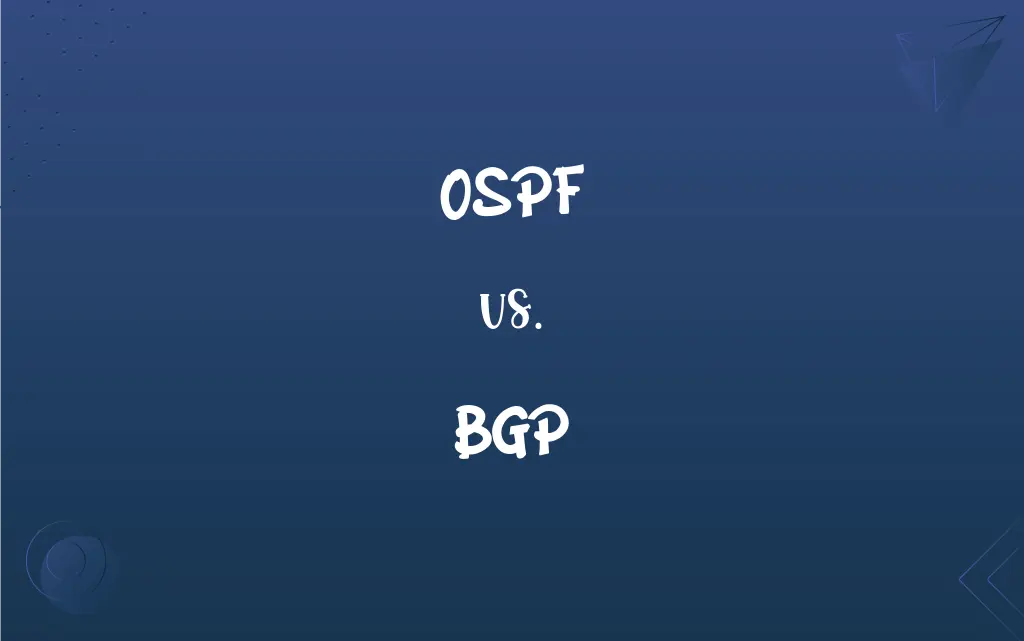OSPF vs. BGP: What's the Difference?
Edited by Aimie Carlson || By Janet White || Published on February 3, 2024
OSPF (Open Shortest Path First) is an interior gateway protocol optimizing routing within a single network, whereas BGP (Border Gateway Protocol) is an exterior protocol for routing between autonomous systems.

Key Differences
OSPF, or Open Shortest Path First, is a protocol used within an autonomous system, typically an individual organization or network, to optimize internal network routing. BGP, or Border Gateway Protocol, on the other hand, is used for routing between different autonomous systems, which are distinct networks controlled by different organizations.
OSPF operates on the principle of finding the shortest path for data packets within a network. It's a type of IGP (Interior Gateway Protocol), designed to manage routing within a single network. BGP, in contrast, manages how packets are routed between different networks, making it an EGP (Exterior Gateway Protocol), vital for the larger-scale routing decisions across the internet.
OSPF uses a metric called cost, based on the bandwidth of the connections, to determine the best path. It's well-suited for more homogenous and smaller networks. BGP, however, uses a complex set of attributes, like path length and network policies, to determine the best path, making it suitable for the diverse and large-scale nature of the internet.
In OSPF, every router within the network has a complete topology map, allowing for efficient routing decisions. BGP routers, conversely, don't have a full map of the internet but rather a path vector protocol, where each router knows the best path to reach a network and shares this information with its neighbors.
OSPF is quicker to converge, meaning it can rapidly adapt to network changes, which is crucial within a single network. BGP, given its scale and complexity, converges more slowly but provides greater control and stability for large-scale, inter-network routing.
ADVERTISEMENT
Comparison Chart
Type of Protocol
Interior Gateway Protocol (IGP)
Exterior Gateway Protocol (EGP)
Function
Optimizes routing within a single network
Manages routing between different networks
Routing Decision Metric
Cost based on bandwidth
Path attributes like length, network policies
Network Topology Knowledge
Complete map of network topology
Path vector protocol, partial knowledge
Convergence Speed
Faster, adapts quickly to changes
Slower, offers stability for large networks
ADVERTISEMENT
OSPF and BGP Definitions
OSPF
OSPF is a routing protocol used within a single autonomous system.
After implementing OSPF, the internal network traffic became more efficient.
BGP
BGP is essential for the operation of the internet, connecting diverse networks.
Thanks to BGP, our local network can communicate with networks around the world.
OSPF
OSPF utilizes a link-state routing algorithm for efficient path selection.
OSPF quickly recalculated the routes when a new link was added to the network.
BGP
BGP can handle large and complex networks, making it suitable for internet routing.
BGP is robust enough to manage the vast and varied routes of the global internet.
OSPF
OSPF distributes routing information between routers in the same autonomous system.
With OSPF, all routers in our office network have updated information about network topology.
BGP
BGP uses a path vector protocol to make routing decisions based on multiple attributes.
BGP's path selection is influenced by factors like network policies and path lengths.
OSPF
OSPF is designed to support hierarchical and scalable network architectures.
We implemented OSPF to ensure our growing network remains manageable and efficient.
BGP
BGP is a protocol that manages how data packets are routed between different autonomous systems.
BGP ensures that internet traffic finds the most efficient path across global networks.
OSPF
OSPF calculates the shortest path using a method based on Dijkstra's algorithm.
OSPF's use of Dijkstra's algorithm helps in efficiently routing the data packets.
BGP
BGP allows for policy-based routing, giving administrators control over the flow of traffic.
We configured BGP to prefer certain routes for security and performance reasons.
FAQs
Is OSPF suitable for the internet?
No, OSPF is designed for internal network routing, not for the large-scale routing of the internet.
What is OSPF?
OSPF is a routing protocol used within a single network to optimize path selection.
What is BGP?
BGP is a protocol for routing data between different networks, essential for the internet.
Can BGP be used within a single organization?
While possible, BGP is typically overkill for single networks and more suited for inter-network routing.
What type of protocol is BGP?
BGP is an Exterior Gateway Protocol (EGP).
What type of protocol is OSPF?
OSPF is an Interior Gateway Protocol (IGP).
How does OSPF work?
OSPF uses a link-state algorithm to distribute routing information within an autonomous system.
What is the main advantage of OSPF?
The main advantage of OSPF is its efficiency in routing within a single network.
How does BGP select routes?
BGP uses a path vector protocol, considering multiple attributes like path length and policies.
Can OSPF handle large-scale routing like BGP?
OSPF is not designed for the scale of routing required by the internet, unlike BGP.
Is BGP used within autonomous systems?
BGP is primarily used for routing between autonomous systems, not within them.
Can BGP adapt quickly to network changes?
BGP has a slower convergence compared to OSPF, prioritizing stability over rapid changes.
What's a key feature of OSPF in network management?
OSPF supports hierarchical structures, making it efficient for large, organized networks.
Does OSPF provide fast convergence?
Yes, OSPF offers quick convergence, adapting rapidly to network changes.
Why is BGP important for the internet?
BGP is crucial for routing data across different networks, making the internet functional.
Is BGP stable for large networks?
Yes, BGP offers stability and scalability for large and complex networks.
How does BGP handle network policies?
BGP allows for policy-based routing, influencing how routes are selected.
Does OSPF use a distance vector protocol?
No, OSPF uses a link-state routing algorithm.
How does OSPF affect network traffic?
OSPF optimizes network traffic within a network for efficiency and speed.
Why choose BGP for global routing?
BGP's ability to manage complex and diverse network paths makes it ideal for global routing.
About Author
Written by
Janet WhiteJanet White has been an esteemed writer and blogger for Difference Wiki. Holding a Master's degree in Science and Medical Journalism from the prestigious Boston University, she has consistently demonstrated her expertise and passion for her field. When she's not immersed in her work, Janet relishes her time exercising, delving into a good book, and cherishing moments with friends and family.
Edited by
Aimie CarlsonAimie Carlson, holding a master's degree in English literature, is a fervent English language enthusiast. She lends her writing talents to Difference Wiki, a prominent website that specializes in comparisons, offering readers insightful analyses that both captivate and inform.







































































